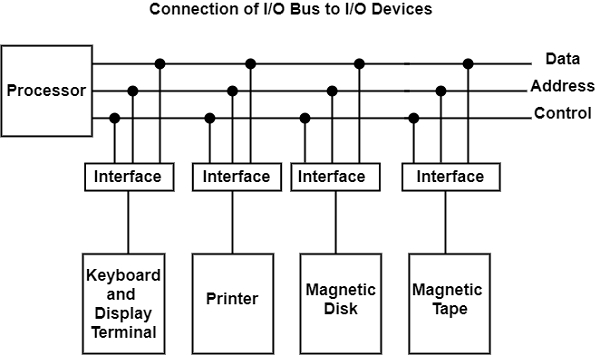
 Data Structure
Data Structure Networking
Networking RDBMS
RDBMS Operating System
Operating System Java
Java MS Excel
MS Excel iOS
iOS HTML
HTML CSS
CSS Android
Android Python
Python C Programming
C Programming C++
C++ C#
C# MongoDB
MongoDB MySQL
MySQL Javascript
Javascript PHP
PHP
- Selected Reading
- UPSC IAS Exams Notes
- Developer's Best Practices
- Questions and Answers
- Effective Resume Writing
- HR Interview Questions
- Computer Glossary
- Who is Who
Discuss the I/O Interface in Computer Architecture?
The I/O interface supports a method by which data is transferred between internal storage and external I/O devices. All the peripherals connected to a computer require special communication connections for interfacing them with the CPU.
I/O Bus and Interface Modules
The I/O bus is the route used for peripheral devices to interact with the computer processor. A typical connection of the I/O bus to I/O devices is shown in the figure.

The I/O bus includes data lines, address lines, and control lines. In any general-purpose computer, the magnetic disk, printer, and keyboard, and display terminal are commonly employed. Each peripheral unit has an interface unit associated with it. Each interface decodes the control and address received from the I/O bus.
It can describe the address and control received from the peripheral and supports signals for the peripheral controller. It also conducts the transfer of information between peripheral and processor and also integrates the data flow.
The I/O bus is linked to all peripheral interfaces from the processor. The processor locates a device address on the address line to interact with a specific device. Each interface contains an address decoder attached to the I/O bus that monitors the address lines.
When the address is recognized by the interface, it activates the direction between the bus lines and the device that it controls. The interface disables the peripherals whose address does not equivalent to the address in the bus.
An interface receives any of the following four commands ?
- Control ? A command control is given to activate the peripheral and to inform its next task. This control command depends on the peripheral, and each peripheral receives its sequence of control commands, depending on its mode of operation.
- Status ? A status command can test multiple test conditions in the interface and the peripheral.
- Data Output ? A data output command creates the interface counter to the command by sending data from the bus to one of its registers.
- Data Input ? The data input command is opposite to the data output command. In data input, the interface gets an element of data from the peripheral and places it in its buffer register.

